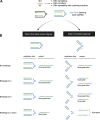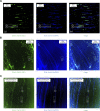DNA combing versus DNA spreading and the separation of sister chromatids
- PMID: 38315097
- PMCID: PMC10840220
- DOI: 10.1083/jcb.202305082
DNA combing versus DNA spreading and the separation of sister chromatids
Abstract
DNA combing and DNA spreading are two central approaches for studying DNA replication fork dynamics genome-wide at single-molecule resolution by distributing labeled genomic DNA on coverslips or slides for immunodetection. Perturbations in DNA replication fork dynamics can differentially affect either leading or lagging strand synthesis, for example, in instances where replication is blocked by a lesion or obstacle on only one of the two strands. Thus, we sought to investigate whether the DNA combing and/or spreading approaches are suitable for resolving adjacent sister chromatids during DNA replication, thereby enabling the detection of DNA replication dynamics within individual nascent strands. To this end, we developed a thymidine labeling scheme that discriminates between these two possibilities. Our data suggests that DNA combing resolves sister chromatids, allowing the detection of strand-specific alterations, whereas DNA spreading typically does not. These findings have important implications when interpreting DNA replication dynamics from data obtained by these two commonly used techniques.
© 2024 Meroni et al.
Conflict of interest statement
Disclosures: The authors declare no competing interests exist.
Figures









Update of
-
DNA Combing versus DNA Spreading and the Separation of Sister Chromatids.bioRxiv [Preprint]. 2023 May 2:2023.05.02.539129. doi: 10.1101/2023.05.02.539129. bioRxiv. 2023. Update in: J Cell Biol. 2024 Apr 1;223(4):e202305082. doi: 10.1083/jcb.202305082. PMID: 37205507 Free PMC article. Updated. Preprint.
References
-
- Bai, G., Kermi C., Stoy H., Schiltz C.J., Bacal J., Zaino A.M., Hadden M.K., Eichman B.F., Lopes M., and Cimprich K.A.. 2020. HLTF promotes fork reversal, limiting replication stress resistance and preventing multiple mechanisms of unrestrained DNA synthesis. Mol. Cell. 78:1237–1251.e7. 10.1016/j.molcel.2020.04.031 - DOI - PMC - PubMed
-
- Belan, O., Sebald M., Adamowicz M., Anand R., Vancevska A., Neves J., Grinkevich V., Hewitt G., Segura-Bayona S., Bellelli R., et al. . 2022. POLQ seals post-replicative ssDNA gaps to maintain genome stability in BRCA-deficient cancer cells. Mol. Cell. 82:4664–4680.e9. 10.1016/j.molcel.2022.11.008 - DOI - PubMed
Publication types
MeSH terms
Substances
Grants and funding
LinkOut - more resources
Full Text Sources

